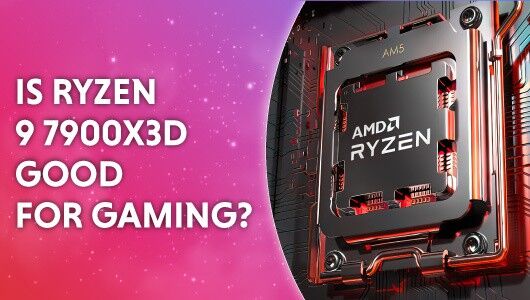Is the Ryzen 9 7900X3D good for gaming?
Is the Ryzen 9 7900X3D good for gaming? let's find out.

WePC is reader-supported. When you buy through links on our site, we may earn an affiliate commission. Prices subject to change. Learn more
The Ryzen 9 7900X3D is expected to hit the markets in February 2023, as confirmed by AMD at CES.
The CPU features AMD’s 3D-V cache technology, which allows L3 cache units to be stacked vertically on top of the processor die, increasing the total L3 cache available to the CPU cores by many multiples of the current standard.
Now read: Is Ryzen 9 7900X good?
The cache is essentially just high-speed storage that can provide data to the CPU much faster than RAM.
Having more of it dramatically reduces the time the CPU has to spend idle waiting for data to be retrieved from memory. In gaming, the time saved is instead spent on generating more frames.
What kind of gaming performance can we expect from the V-cache-enhanced variant of AMD’s second-best processor? Let’s find out.
Ryzen 9 7900X3D Specifications
Here are the processor’s base specs:
- Core count: 12 (Multithreading enabled)
- Thread count: 24
- Core clock: 4.4GHz
- Boost clock: 5.6GHz
- L2 cache: 12MB – 1 MB per core
- L3 cache: 128 MB
- TDP: 120 watts
- iGPU: Radeon Graphics
- Socket: AM5
The Ryzen 9 7900X3D features a record 128MBs of L3 cache. This figure will be matched only by the 7950X3D.
Is the Ryzen 9 7900X3D good for gaming?
The Ryzen 9 7900X3D is shaping up to be an excellent gaming processor. It’s a step up from the 7800X3D, especially in multicore performance – perfect for gamers who engage in streaming and content creation on the side.
It will also be more affordable than the 7950X3D flagship while offering similar gaming performance (games will almost always be GPU-bound with both processors).
It’s an excellent choice for those interested in upgrading their PCs with AMD’s V-cache technology but don’t want to break the bank with the 7950X3D or settle for a 16-thread 7800X3D.
Here’s why the Ryzen 9 7900X3D will be so good for gaming.
3D V-cache
The 128MBs of 3D V-cache available to this processor will excel in the kind of processing scenarios presented by gaming. Gaming derives great benefit from having the extra available cache memory.
We’ve known this for a fact ever since this CPU’s predecessor, the Ryzen 7 5800X3D was released.
It offered 15% higher FPS in gaming over the standard 5800X, despite having a 200MHz lower boost clock.
This just goes to show how much of a difference 3D V-cache really makes.
High boost clock
We originally expected the Ryzen 9 7900X3D to have a lower boost clock than the standard 7900X.
V-cache is very temperature sensitive, so boost clocks had to be toned down in the 5800X3D and 7800X3D.
The Ryzen 9 7900X3D, however, retains its incredible 5.6GHz boost clock. Your games will run on high-performing single threads, all while enjoying the benefits of 3D V-cache.
Power efficiency
Power efficiency isn’t usually a direct influencer of performance, but given that the newer CPUs from both Intel and AMD have frequently fallen victim to thermal throttling because of their 200-watt TDPs, it practically is nowadays.
The Ryzen 9 7900X3D runs at a much more comfortable 120 watts, meaning it’s surprisingly power efficient.
You also won’t need as strong of a cooling solution to keep the CPU’s temperatures in check, which is a nice bonus.
How does AMD’s 3D V-cache boost gaming performance?
AMD has introduced a new technology called 3D V-cache, which involves adding a 64MB on-die cache to its Ryzen 7000 and 5000 series processors. This cache is constructed using a 3D stacking technique that places it closer to the processor cores, reducing the distance data has to travel and hence minimizing latency.
This on-die cache addition provides the processor with a larger quantity of high-speed memory, leading to enhanced performance in applications, including gaming, that require high-speed memory. By decreasing the number of times the processor accesses slower system memory, the increased cache can increase the processor’s overall efficiency and speed.
The precise impact of 3D V-cache on gaming performance is dependent on several factors, including the game played and the rest of the system setup. However, early benchmarks indicate that the technology can provide significant performance gains in certain circumstances.
Final word
Overall, the processor will likely offer you excellent gaming performance, with enough cores to multitask and do productivity work on the side.
Its price-to-performance ratio is yet to be determined (AMD hasn’t revealed the price yet), but it looks like a solid option for gamers based on its specs.